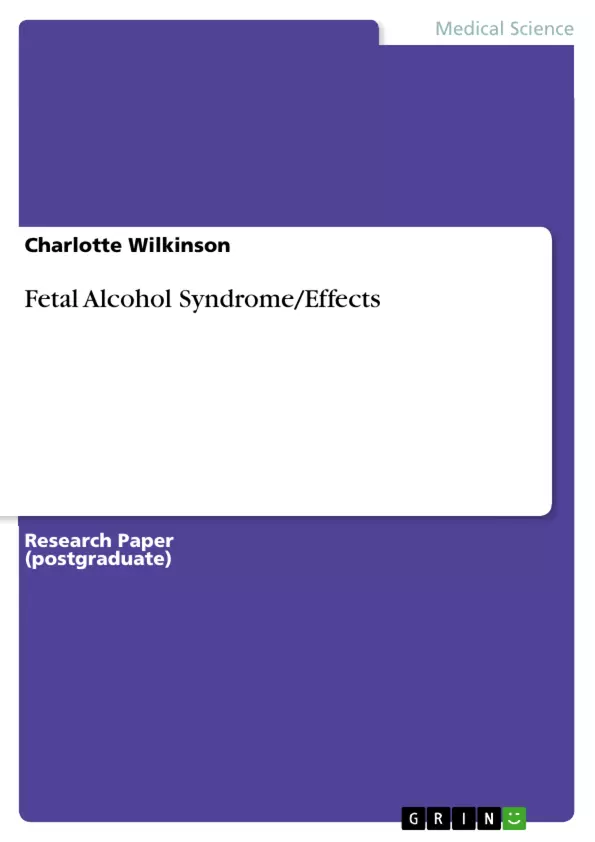Fetal Alcohol Syndrome (FAS) is a part of Fetal Alcohol Spectrum Disorder, and is also referred to as Fetal Alcohol Effects. However, FAS is the clinical diagnosis term for any one on the spectrum. So for the purposes of this paper, it will be referred to as such. FAS is one of the leading causes of preventable birth defects and developmental delays (Graefe, 2003). It is a form of brain injury caused by alcohol usage by the mother during pregnancy, and is more prevalent in our world than many people are aware of. 9 out of every 1000 births are FAS births (Knowledge Network 2009), and as many as 1 in 4 births may have had alcohol exposure, but no noticeable effects. There is no association between paternal alcohol consumption and birth outcome (Saskatchewan Institute on Prevention of Handicaps, 2000). Contributing factors to the cause of FAS include malnutrition, other drug usage, already having a child with FAS, and having a history of substance abuse. It is not genetic or inherited (Graefe, 2003).
Inhaltsverzeichnis (Table of Contents)
- Fetal Alcohol Syndrome
- Causes of FAS
- Effects of FAS
- Physical Effects
- Emotional and Intellectual Effects
- Infancy and Toddler Years
- School Years
- Adolescence
- Adulthood
- Secondary Disabilities
- Diagnosis of FAS
- Prevention of FAS
- Living with FAS
- Support for Individuals with FAS
Zielsetzung und Themenschwerpunkte (Objectives and Key Themes)
This research paper provides an overview of Fetal Alcohol Syndrome (FAS), a leading cause of preventable birth defects and developmental delays. The paper discusses the causes, effects, diagnosis, prevention, and support for individuals with FAS. Key themes explored in the paper include:- The impact of prenatal alcohol exposure on fetal development
- The range of physical, emotional, and intellectual challenges faced by individuals with FAS
- The importance of early diagnosis and support for individuals with FAS
- The role of education and awareness in preventing FAS
- Strategies for supporting individuals with FAS throughout their lives
Zusammenfassung der Kapitel (Chapter Summaries)
This research paper is divided into several sections covering different aspects of Fetal Alcohol Syndrome. The first section introduces FAS as a part of Fetal Alcohol Spectrum Disorder and explains its prevalence. It discusses contributing factors to FAS, emphasizing that it is not genetic or inherited. The second section focuses on the effects of FAS, exploring the physical, emotional, and intellectual manifestations of the condition. It provides a detailed description of facial abnormalities, other physical characteristics, and the intellectual and emotional challenges faced by individuals with FAS at different stages of life. The third section discusses secondary disabilities associated with FAS, highlighting the potential for overlapping diagnoses with other developmental disabilities. The fourth section addresses the diagnosis of FAS, emphasizing the importance of early identification and the process involved in obtaining a diagnosis. The fifth section focuses on the prevention of FAS, emphasizing the importance of abstaining from alcohol during pregnancy. The final section explores the challenges faced by individuals with FAS throughout their lives and provides strategies for supporting them. It highlights the importance of creating a supportive environment, providing educational and psychological support, and fostering understanding within families and communities.Schlüsselwörter (Keywords)
Fetal Alcohol Syndrome (FAS), Fetal Alcohol Spectrum Disorder (FASD), prenatal alcohol exposure, birth defects, developmental delays, physical effects, emotional effects, intellectual effects, secondary disabilities, diagnosis, prevention, support, awareness, education.- Citation du texte
- Charlotte Wilkinson (Auteur), 2009, Fetal Alcohol Syndrome/Effects, Munich, GRIN Verlag, https://www.grin.com/document/148747



